

1988-1992 was something of a golden time for Homo Promos. We had just formed; we were programming Pride Cabaret which gave us lots of contacts; we’d been on the Section 28 demonstrations as a group. We organised benefits for Outrage!, Lesbian and Gay Switchboard as it was then, and the British version of ACT-UP. We were riding high in the gay public’s estimation.

But most of all, we had talent. Ian Lucas had come to us as a director of Leather; he chivvied this into production with the gentlest of guiding hands and calmed down a hothouse atmosphere which brought out traumatic backstories for more than one actor. Some things are still difficult to talk about.
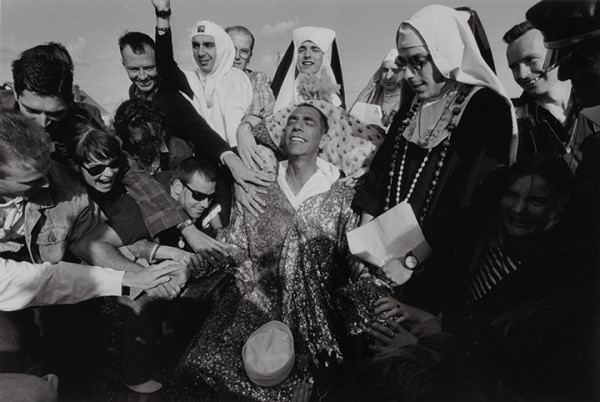
Ian was a member of the Sisters of Perpetual Indulgence (Sister Frigidity), of ACT-UP and Outrage! This commitment to radical queer politics, and to the theatricality of radical queer politics, resulted in a book, Impertinent Decorum, which features a chapter on Homo Promos’ work. He also wrote two plays at this time, Dolphins Can Swim and Triptych.
These were productions which almost created their own repertory company, and they involved some very fine people.
Simon Kennett, the mainstay of the company during these years, started with Dorothy’s Travels, and was in pretty much every show we did for the next four years, except the all-women one, Flying Lessons. He had a great singing voice which acquired over the years a smoker’s rasp, a commanding stage presence, and formidable acting skills which worked equally in comedy and serious plays.
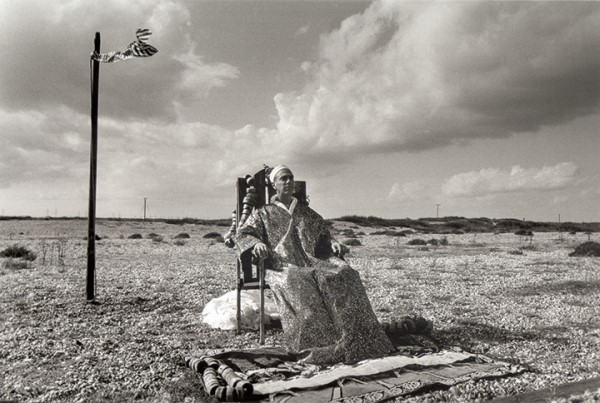
An Essex Boy in the best sense, he was kind, charming, funny, beautiful and acquired his own personal following. He was also, with Ian, an AIDS activist and Sister of Perpetual Indulgence (Sister Jack-Off-All-Trade-Master-Of-Nuns). He died of AIDS in 1997, his last act of subversion posing for a picture, naked, for Richard Sawdon Smith, when he was quite close to the end. The year after I wrote the ‘anti-Requiem’ Free In his memory.
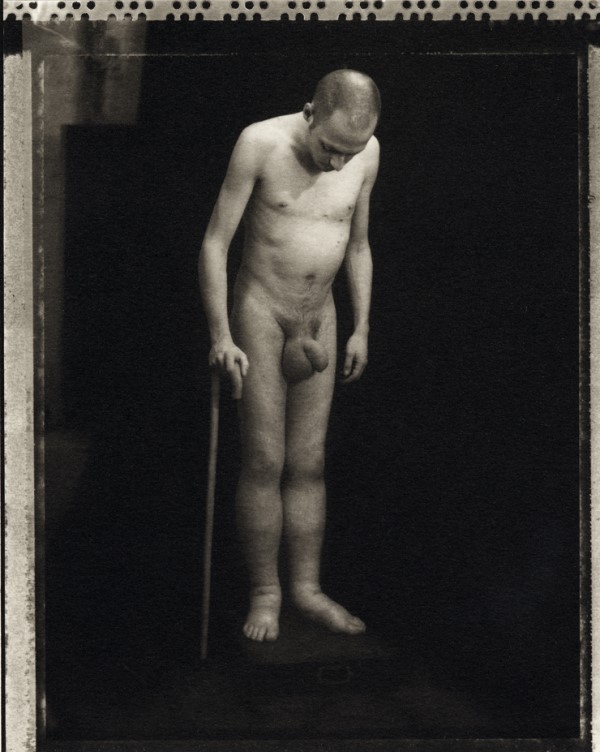
This picture of Simon by Richard Sawdon Smith won the 1997 John Kobal Photographic Portrait Prize, but the sponsors of the Prize, the Sunday Times, refused to publish it.
It appeared in The Guardian as the Picture of the Week a little later.
Phil Telford had been a member of the sublime queer harlequinade that was Bloolips, which elevated trash drag to high art. He was their pianist for several years. Later he was an occasional cabaret star, performing his own, unexpectedly poignant, material. He came into the company when we put on the second version of Wednesday Matinee at the Drill Hall as a benefit.
This was followed by working with Ian. Later he moved first to Bristol to be a therapist and subsequently back to his hometown of Southport. From there he writes crime novels set in a thinly disguised version of the town, under his other name of Phil Booth.
Matthew Hodson, then working under the stage name of Joshua Matthews, was involved most importantly in the unruly monster that was Leather, the Drill Hall Benefit and these two plays of Ian’s. He went into the voluntary sector, firstly to GMFA and currently to NAM Aidsmap as Executive Director.
Matthew has re-joined us, under his own name, to give a series of stonking performances in the online Zoom readings we have been giving during the pandemic since March 2020.
Triptych is, as the name implies, a set of three monologues, set in Britain at the time of the Roman Conquest, in Norway during the Second World War, and in Vietnam in the late 1960s. They were written to provide a voice for characters who had been marginalised, overlooked.
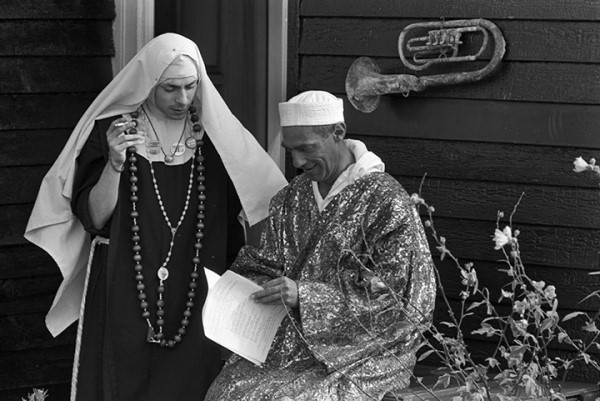
Simon (left)
MARBAN: The boy priest in particular is silent in The Romans in Britain. His rape, a symbol of colonial pillage, became notorious when the play and the National Theatre were prosecuted by Mary Whitehouse in a private action for ‘procuring an act of gross indecency in contravention of the Sexual Offences Act of 1956’.
The resulting furore obscured both the parallels with the British occupation of Northern Ireland and the use of anal sex as part of the metaphor. Marban in the play is a silent character. Ian gives him a voice, to protest the destruction of his Celtic culture, the destruction of his identity. Played originally by Matthew Hodson.
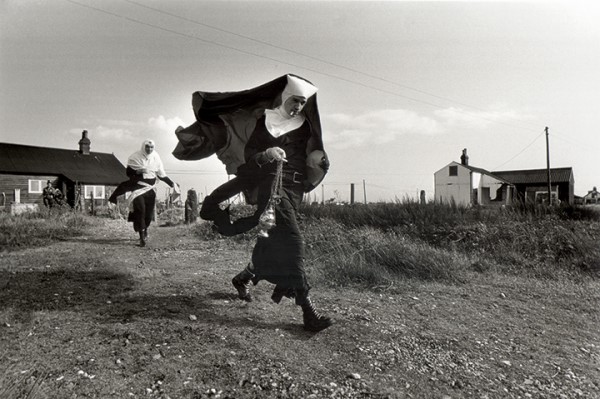
INGA: The character of Inga, the drag artiste who uses his ability to disguise himself convincingly as a woman to run lines for the Norwegian Resistance from Norway to Sweden and back, came from Leigh Rutledge’s Gay Book of Lists.
There is a portrait of him in full drag in the Resistance Museum in Oslo. From Rutledge’s paragraph in ‘4 gay victims of the Nazis’, Lucas constructed a portrait of a man who used camp and irony to retain his sense of identity under torture. Played by Phil Telford.
COLOUR US BEAUTIFUL: The Soldier is again a result of literary inspiration – a memoir of gay soldiers in Vietnam - but brought into vivid visual focus by placing the soldier in the field with his dead lover; dead because he was refused permission to rescue him. His grief and anger are played out against the rock and roll of ‘Blue Suede Shoes’ – Presley version. Played by Simon Kennett.
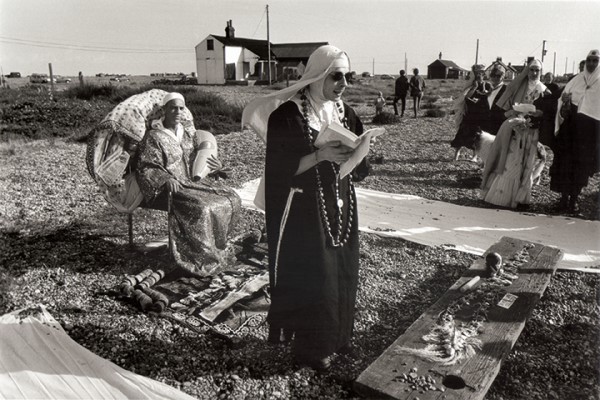
Ian writes: “They (the monologues) seemed to go together as a 'forgotten story' form of Queer theatre - I spent some time directing the three actors for Camden but, to be honest, I think they delivered their parts largely as a result of work they themselves had done - Simon was great as the soldier, and Phil found a woozy masculinity in Inga that both went beyond what I'd imagined.”
The plays were performed in the Castlehaven Community Centre in July 1992.
Images: Canonisation of Derek Jarman 1991 pictures by Ed Sykes
Read the Script
View the YouTube recording
This website uses Cookies
© Homo Promos